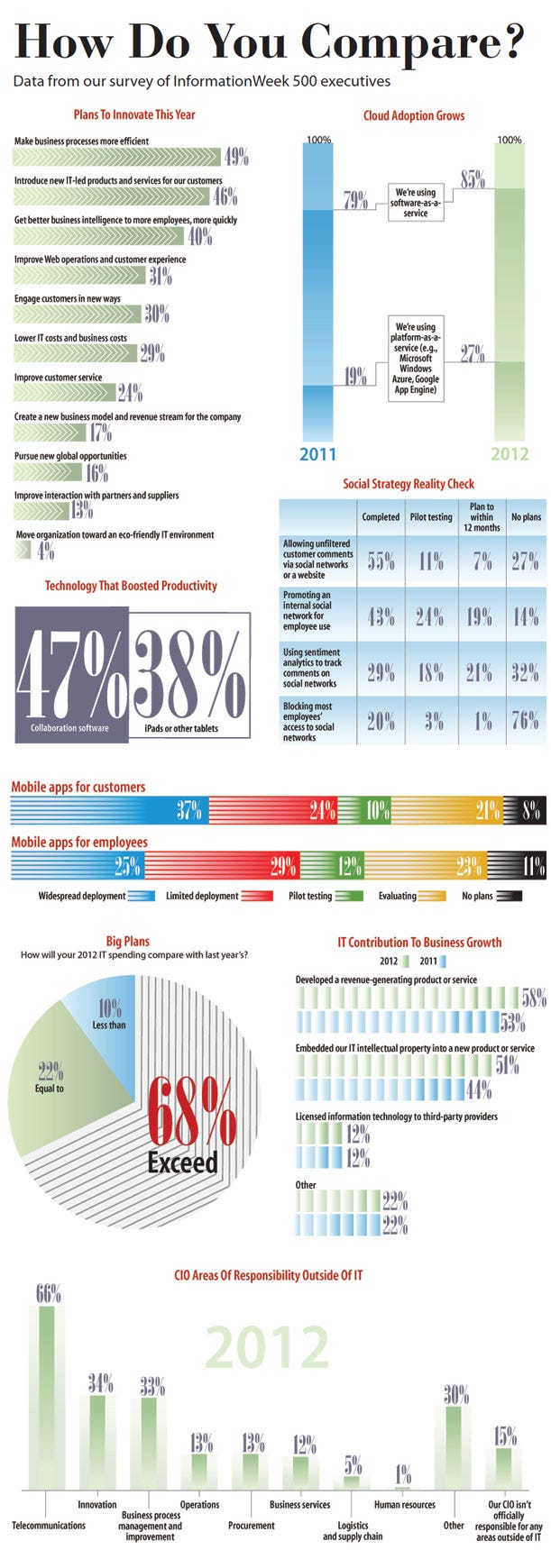IW 500 Data Shows How IT Rules Have ChangedIW 500 Data Shows How IT Rules Have Changed
For every cost-cutting priority, there's an equally important customer-focused initiative.


Mobile devices, cloud computing, and big data analytics are blowing the old IT rules to pieces. Where companies once turned to their IT organizations for tech support, they now need technology embedded into their products and services. This customer-facing role for IT has been growing ever since the dawn of the Web, but now its a win-or-lose imperative. What were seeing in this years information 500 ranking of the most innovative U.S. users of business technology is how the very best IT organizations are changing to play by these new rules.
In our survey of these 500 innovators, for every efficiency and cost-cutting priority, we see a customer-centric priority as well. Asked to name the top three areas in which they expect to innovate, 49% of IW 500 companies cite improving the efficiency of business processes, making this efficiency area the most-cited priority. But thats down five points from a year ago, and down from 60% back in 2009s recession. Very close, noted by 46% of the 500 companies this year, is introducing new IT-led products and services for customers. Back in 2009, only 37% had that as a top priority. (See more IW 500 data on the next page.)
Likewise, 29% cite lower business or IT costs as a priority, down sharply from 2009, when 47% did. Right alongside this cost focus is improve Web operations and customer experience (31%) and engage customers in new ways (30%--up a whopping 10 points from 2009).
We see the rise of customer-facing technology just as clearly in the IT projects of our IW 500 leaders--from Deere & Co. putting wireless diagnostics software in tractors to UPS letting customers give drivers instructions on where to leave a package.
Mobile apps are a major driver of the customer focus--companies are getting mobile apps out to customers even faster than they are to employees. Already, 37% of IW 500 companies have widespread deployment of customer-facing mobile apps, compared with 25% for employees. Another third have such mobile apps in limited deployment or pilot for customers. Whether its Vail Resorts giving a smartphone app to skiers or Royal Caribbean putting an iPad in every room of some cruise ships, CIOs are accepting that customers dont want to unplug--they want relevant apps that add to their experience. And ITs working closely with marketing to deliver.
Big wins are possible with employee-facing apps, too--38% say that deploying iPads or other tablets is among their biggest productivity boosters. But tablet or smartphone apps are only a hit if theyre finely tuned to employee needs. Thats what IT did at Simon Property Group, the countrys largest shopping mall owner, for a tablet app that can show details and images of all of the companys properties available for rent--an app it credits with helping close deals it otherwise would have missed.
Cloud computing is firmly established among IW 500 companies. Eighty-five percent use cloud software, and 27% use a cloud platform-as-a-service, such as Microsoft Azure and Google App Engine, up eight points from a year ago. But companies arent just using cloud computing as a platform for internal apps; theyre using it to offer new products to customers. Zynga has taken this trend full circle. It launched its social online gaming business using Amazons pay-for-use cloud infrastructure. Now its big enough that it has brought much of that computing to its own data center, and its launching its own cloud service--letting newbie game companies rent its infrastructure to run their own games.
With big data analytics, the disruptive impact has just begun. Look at its use to analyze social media sentiment. Three-fourths of IW 500 companies use social networking tools to collaborate with customers and suppliers, up from 42% in 2009. But just 29% use sentiment analytics to assess what people are saying about their companies and products on social and other sites. Another 39% have sentiment analytics in pilot testing or plan to roll it out within a year, but a third have no plans to use it.
Forty percent of IW 500 companies put better business intelligence for employees among their innovation priorities, but that number has barely budged in recent years. More telling is how IT is using analytics--like at Beth Israel Deaconess Medical Center, the No. 1 IW 500 company, where CIO John Halamka is daring to give more clinicians access to huge amounts of data to run queries. Speed of processing has changed the rules for analytics: A clinician can search BIDMCs 200 million data points on 2.2 million patients for how many have breast cancer and took ACE inhibitors, and the answer comes back in three seconds.
The innovators realize the rules for IT have changed, and CIO roles are changing accordingly: One-third of IW 500 CIOs now have formal responsibility for innovation in their companies, more than double the 16% who did in 2009.

Go to the story:
How The information 500 Are Chosen

Go to the 2012 information 500 homepage
About the Author
You May Also Like






